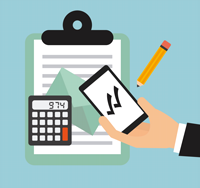Think, just more than a century ago, consumer to business payments were made using only cash and coins. Today, the majority of payments are made via any number of electronic payment methods and can be made in person, over the phone, or online. The Federal Reserve estimates that there were almost 123 billion electronic (noncash) payments made in the United States in 2012, with a value of $79 trillion. While the concept of electronic payments is pretty simple – it’s basically an electronic transfer of funds – the methods for accepting electronic payments can get complicated.
Card Payments
Card payments – including credit, debit, and prepaid cards – make up the majority of electronic transactions, with debit cards accounting for most of card transactions. In 2012, there were 47 billion debit card payments compared to just 26.2 billion credit card payments.
Debit cards are an electronic method that allows consumers to pay using money in their checking account. The first version of the debit card, which appeared in the 1960s, could only be used in an ATM to withdraw money and perform other basic bank functions. Just a couple of decades later, banks and credit card networks capitalized on the existing credit card framework to add a debit function to ATM cards allowing consumers to use the cards to make purchases. It wasn’t long before debit card use outpaced checks and eventually credit cards.
The first version of a credit card was offered by oil and department stores in the early 1900s and could only be used in the store the card was issued. Years later, a general purpose credit card was developed, but it was limited to specific geographical areas. To solve that problem, several banks joined together to create the first credit card network, allowing cardholders to use credit cards all over the country.
In 1970, only 16% of households had a credit card and by 1995, approximately 65% of households at least one credit card according to a 2001 report by the Federal Reserve Bank of Philadelphia. In the beginning, the credit card relationships were pretty simple involving only the merchant, the customer, and the bank. These early credit card issuers had a lot of responsibilities – issuing and authorizing credit cards, making payments to creditors, and collecting payments from consumers.
As more banks became interested in issuing credit cards and more companies interested in processing credit cards, the relationships became more complicated. Merchants who accept credit cards today know that there are several entities involved in the credit card process – the acquiring bank, the issuing bank, and the processing network.
Prepaid cards are a relatively new way of making purchases, created in part to replace gift certificates and also to service consumers who don’t have a bank account. Prepaid cards are similar to debit cards in that they pull from an existing source of funds instead of a credit account, but prepaid cards aren’t linked to a bank account. The cards start out with a zero balance. Once the consumer loads the card with funds, it can be used just like a debit card, but must funds must be replaced once the balance is depleted. There’s no overdraft protection, so transactions that exceed the available balance are declined. From a merchant perspective, prepaid cards are best for one-time, “known amount,” transactions, not for recurring or ongoing bills.
ACH
ACH is a method of transferring funds from one bank account to another bank account, developed in the late 1970s as a faster cheaper method of processing checks. Business to consumer payments and consumer online payments account for a large portion of ACH payments. Many ACH transactions are made from checks that have been converted to ACH for easier and faster processing. While, there were more than 22 billion ACH payments made in 2012, the Federal Reserve reports an overall deceleration in the growth of ACH payments.
Remote Deposit

Remote deposit allows a merchant to scan a check and submit either the check image or the ACH data – routing and checking account number – to the bank. These deposits are then transmitted and processed electronically. Depending on the volume of checks, banks offer different types of hardware to process checks. Merchants with a low volume of check can use a smartphone to capture images of the check.
As technology advances, the ways that consumers can make electronic payments continues to evolve. Today, consumers can make mobile payments with their smartphones through a mobile app, at the point-of-sale using near field communication, and in some cases, via text message. Merchants want to remain agile in their payment options, allowing consumers to make payment in the method that’s available and convenient for them.
– HealPay blogger, LaToya Irby